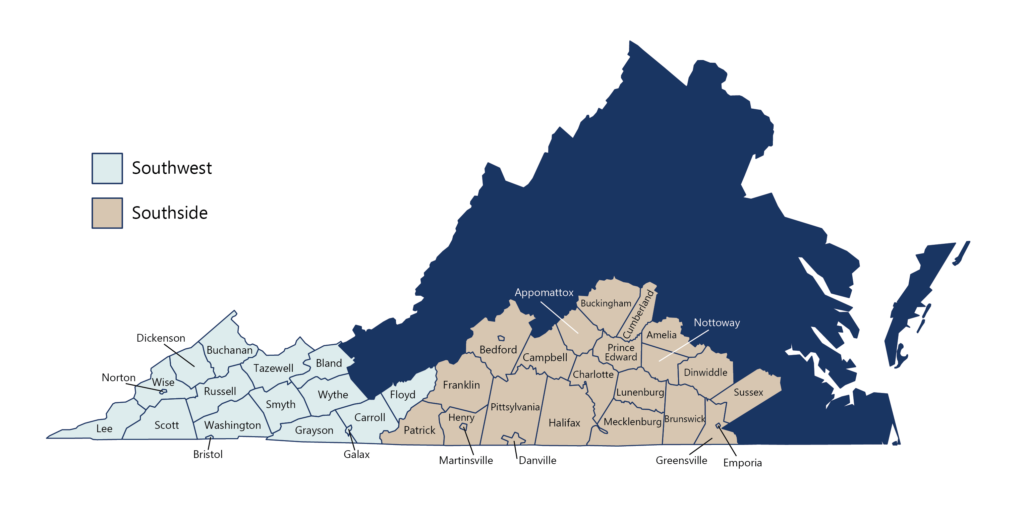The Commission’s service area includes 40 tobacco-dependent localities in Southern and Southwest Virginia. Local governments and nonprofits serving those localities are eligible to apply to the Commission’s grant and loan programs for projects that will enhance the economic growth and development of the region. See our Grant and Loan Programs page for more information on specific programs.
Tobacco Region Localities:
Counties of: Amelia, Appomattox, Bedford, Bland, Buchanan, Brunswick, Buckingham, Campbell, Carroll, Charlotte, Cumberland, Dickenson, Dinwiddie, Floyd, Franklin, Grayson, Greensville, Halifax, Henry, Lee, Lunenburg, Mecklenburg, Nottoway, Patrick, Pittsylvania, Prince Edward, Russell, Scott, Smyth, Sussex, Tazewell, Washington, Wise, Wythe
Cities of: Bristol, Danville, Emporia, Galax, Martinsville, Norton
*The City of Lynchburg is not in the Tobacco Region
Learn more about the Commission’s history and vision below.

History
Vision
In 1998, the Attorneys General of 46 states signed the Master Settlement Agreement (MSA) with the four largest tobacco companies in the United States to settle state suits and recover billions of dollars in costs associated with treating smoking-related illnesses. Four states – Florida, Minnesota, Mississippi, and Texas – settled their tobacco cases separately from the MSA states. A portion of the MSA proceeds funded the creation of the Tobacco Region Revitalization Commission.
Chapters 31 and 31.1 of Title 3.2 of the Code of Virginia contain statutes governing various aspects of the Commission. Broadly, those serving the Commission may be split into two groups – members (or commissioners) and staff.
The Commission is composed of 28 members, and appoints from its membership a chairperson and vice-chairperson. These and other details on membership are described in §3.2–3102. Members are appointed to one or more committees. Each committee is assigned a chairperson by the Commission chair; some committees have a vice-chairperson or are structured to have co-chairs.
In today’s environment – where markets are largely global and employment is increasingly knowledge-based – the Commission seeks to accelerate regional transformation, giving citizens expansive opportunities for education and employment, and providing communities the benefits of economic stability, diversification, and enhanced prosperity. In particular, the Commission seeks to meet the region’s specific challenges related to a historic dependence on tobacco production, textile and furniture manufacturing, and coal production.
As a result, the Commission also recognizes that investments should reflect and directly advance local, regional and state priorities as established by elected and appointed officials, representatives from institutions of higher education, and other community leaders. The Commission views economic development as a partnership, and will – as often as practicable -seek input from regional stakeholders to ensure its priorities align with those of the region.
The Commission’s work is grounded in an objective and quantifiable economic base analysis. In general, directly productive industries, and the workforce training and development which supports them, do more to further this goal and should be favored over an increase in service industries primarily serving local markets.
Finally, the Commission must focus on ensuring the maximum impact of its expenditures, both as they relate to creating economic growth, and as they relate to maintaining the Commission’s fiscal sustainability as a critical source of capital to the region the Commission serves.